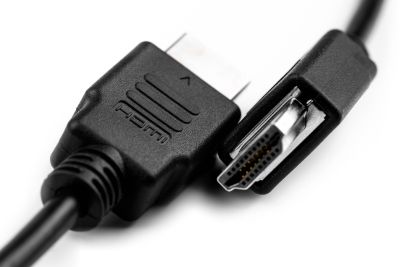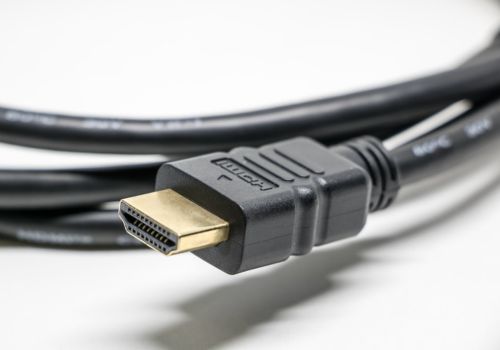
The easiest way to check your HDMI cable version is by examining the text on its body. However, you can also take a look at the packaging that it came in or its receipt.
If you want to switch things up, you can try and plug your cable into your computer, and then check its max resolution and refresh rate. If you're able to "connect the dots", you should be able to figure out what HDMI version it is (more on how later on).
I've used my fair share of HDMI cables for my PC set-up and consoles. At first, I was a bit confused by their different versions, but I quickly realized that they're almost the same except for their speed.
If you'd like to know more about this, and all the different versions of HDMI and their uses, I've got you covered.
Contents
There are a few ways to check your HDMI cable version, and I've run through them below.
Let's get to it.

The easiest way to find your HDMI cable version is by checking the text on its body. If you look closely, there should be information on its HDMI standard somewhere near its port.
Even if you can't see its HDMI version, you might find out what its maximum resolution and refresh rate are. Each HDMI version comes with its own specs. So, with some research, you'll be able to figure out what type of cable it is. I've included a table below that will help.
| HDMI Cable Version | Max Resolution / p | Max Refresh Rate / Hz | Max Bandwidth / Gbps |
|---|---|---|---|
| Standard | 720 or 1080 | 30 or 60 | 4.95 |
| High-Speed | 1080 or 4K | 30 or 144 | 10.2 |
| Premium High-Speed | 1080 or 4K | 60 or 240 | 18 |
| Ultra High-Speed | 4K or 8K | 60 or 120 | 48 |
If you have the packaging that your cable came in, you can use it to find out what version your HDMI cable is. This information should be somewhere on the back.
Now if you don't have its packaging, see if you have its manual or receipt. Your cable version should be mentioned on them.
What should you do if you don't have either of the above? You can still figure out your HDMI version by finding your HDMI cable on Amazon (or the store you bought it from). There should be details about it given in the product description.
Last but not least, you can use a computer to find out what your HDMI cable version is. This is a bit more complicated, but it might be the only way to go if you're still having no luck.
As mentioned, each HDMI version comes with its own resolution and refresh rate. The table given above can help you figure out what type of HDMI it is.
Also, you will need an external device, like a streaming stick to use with your PC. Once you plug your external device and HDMI into your Windows computer, do the following:
On Mac computers:
HDMIs can be divided into 4 main types - standard, high-speed, premium, and ultra-high speed.
I've taken a look at them in-depth below. However, before I get started, know that many users confuse HDMI cable versions with different revisions, like HDMI 1.4, 2.0 even 2.1. These "revisions" are not actually separate versions, as some ultra high-speed HDMIs can come with HDMI 2.0 specs, and some premium high-speed HDMIs come with HDMI 2.1 specs.
With that out of the way, let's take a look at each of the four HDMI cables below.

Standard HDMI cables can transmit digital video and audio signals at 4.95 Gbps. Yes, they are the most common HDMI type. You probably guessed this from their name.
They come with a maximum supported resolution of 720 p at 60 HZ and can support 3D video, as well as the use of Audio Channels.
Standard HDMIs are typically used to plug TVs to DVD players and gaming consoles.
HDMI 1.0 and 1.2 fall into the Standard category.
High speed HDMIs can transfer audio and video at 10.2 Gbps. They're perfect if you're trying to watch 4K or use a Blu-ray player.
HDMI 1.3 and 1.4 are all high-speed HDMIs.
Premium high speed HDMIs come with an impressive 18Gbps maximum bandwidth, and can also support 4K resolution at 60 HZ.
They can support HDR content, and handle expanded color spaces.
HDMI 2.0 falls into the premium high-speed cable category.
Last but not least, we have Ultra high-speed HDMIs. They can transfer audio and video between two multimedia devices at 48 Gbps. They can handle 8 or even 10k video at 120 HZ.
HDMI 2.1 falls into the ultra high speed HDMI cable category.
Answered below are some popular questions on HDMI cables.
HDMI cables are all backward compatible. To break it down, this basically means that you'll be able to use any HDMI cable and device together.
Just remember that if the HDMI cable you've connected is a lower version than what you need, the audio and video being transferred will have a lower maximum resolution and refresh rate.
HDMI 2.0 and 2.1 are both revisions of the HDMI cables. So as you can imagine, the 2.1 revision comes with newer features.
The biggest difference between the two cables has to be their bandwidth capacity. HDMI 2.0 version has a bandwidth capacity of around 18 Gbps, while HDMI 2.1 has a 48 Gbps capacity.
It can transfer more data at a time, which allows it to support higher resolutions and faster refresh rates. You can use HDMI 2.1 if you want to watch 8k videos, while 2.0 can only handle 4k.
HDMI 2.1 supports 8K at a 60 Hz refresh rate, or 4K at 120 Hz, while HDMI 2.0 only supports 4K at 60 Hz. The refresh rate is how many times the display refreshes per second; so the higher the refresh rate on version 2.0, the smoother the motion will be.
Both revisions support HDR, which is a special feature that increases the range of light and color that a video can display.

You can find out what HDMI cable version you're using by checking the cable, or the box that it came in.
You can also find out what your cable version is by connecting it to your PC, then figuring out its max resolution and refresh rate. This takes some work, but it's a neat trick if you want to learn more.
I also took you through the Standard, High-speed HDMI, and Premium high-speed cable types.
Hopefully, you found this guide useful and learned about the different HDMI versions.
